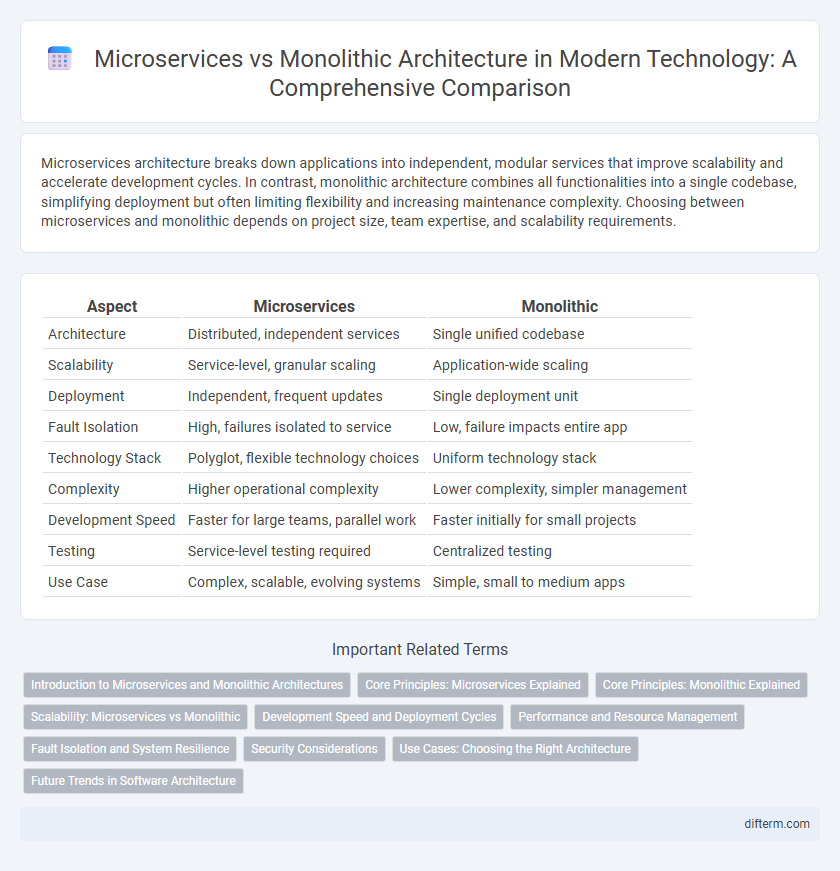Microservices architecture breaks down applications into independent, modular services that improve scalability and accelerate development cycles. In contrast, monolithic architecture combines all functionalities into a single codebase, simplifying deployment but often limiting flexibility and increasing maintenance complexity. Choosing between microservices and monolithic depends on project size, team expertise, and scalability requirements.
Table of Comparison
| Aspect | Microservices | Monolithic |
|---|---|---|
| Architecture | Distributed, independent services | Single unified codebase |
| Scalability | Service-level, granular scaling | Application-wide scaling |
| Deployment | Independent, frequent updates | Single deployment unit |
| Fault Isolation | High, failures isolated to service | Low, failure impacts entire app |
| Technology Stack | Polyglot, flexible technology choices | Uniform technology stack |
| Complexity | Higher operational complexity | Lower complexity, simpler management |
| Development Speed | Faster for large teams, parallel work | Faster initially for small projects |
| Testing | Service-level testing required | Centralized testing |
| Use Case | Complex, scalable, evolving systems | Simple, small to medium apps |
Introduction to Microservices and Monolithic Architectures
Microservices architecture divides applications into small, independent services that communicate through APIs, enhancing scalability and maintainability. Monolithic architecture consolidates all functions into a single, unified codebase, simplifying initial development but limiting flexibility and scalability. Organizations often choose microservices for complex, evolving systems requiring continuous deployment and monoliths for simpler, tightly integrated applications.
Core Principles: Microservices Explained
Microservices architecture breaks down applications into independent, loosely coupled services that focus on single business capabilities, promoting scalability and flexibility. Each microservice communicates through lightweight protocols like HTTP/REST or messaging queues, enabling continuous deployment and fault isolation. Contrastingly, monolithic architecture bundles all functionalities into a single deployable unit, limiting agile development and scalability.
Core Principles: Monolithic Explained
Monolithic architecture consolidates all components of an application into a single, unified codebase, simplifying deployment and development. This approach emphasizes tight coupling of modules, enabling straightforward communication but limiting scalability and flexibility. Core principles include centralized management, synchronized updates, and a singular runtime environment, which can lead to challenges in maintaining and evolving complex systems.
Scalability: Microservices vs Monolithic
Microservices architecture enables independent scaling of individual components, allowing precise resource allocation based on demand, which significantly enhances overall system scalability. In contrast, monolithic architectures require scaling the entire application as a single unit, often leading to inefficient resource use and higher operational costs. This granular scalability advantage makes microservices ideal for dynamic workloads and rapid growth environments.
Development Speed and Deployment Cycles
Microservices architecture accelerates development speed by enabling independent teams to work on discrete components simultaneously, reducing bottlenecks inherent in monolithic systems. Deployment cycles are shorter and more frequent in microservices due to isolated service updates, minimizing downtime and allowing rapid iteration. Monolithic architectures often result in slower development and longer deployment cycles because changes require full application builds and comprehensive testing before release.
Performance and Resource Management
Microservices architecture enhances performance by enabling independent scaling of services, reducing system-wide bottlenecks common in monolithic systems. Resource management is optimized as microservices allocate computing power dynamically based on specific service demands, unlike monolithic applications that require scaling entire systems regardless of individual component load. This granular control in microservices minimizes resource wastage and improves overall application responsiveness.
Fault Isolation and System Resilience
Microservices architecture improves fault isolation by encapsulating failures within individual services, preventing system-wide outages and enhancing overall system resilience. In contrast, monolithic architectures risk cascading failures since a fault in one module can affect the entire application. This isolation in microservices supports continuous availability and easier fault recovery through targeted rollbacks or restarts.
Security Considerations
Microservices architectures enhance security by isolating components, limiting the blast radius of attacks through containerization and fine-grained access controls, whereas monolithic systems present a larger attack surface due to their unified codebase. Implementing security policies such as API gateways, zero-trust models, and automated vulnerability scanning is crucial for microservices to manage inter-service communication and prevent lateral movement by attackers. Monolithic applications require comprehensive patch management and robust input validation to mitigate risks arising from their monolithic structure and shared resources.
Use Cases: Choosing the Right Architecture
Microservices architecture is ideal for complex, large-scale applications requiring scalability, agility, and rapid deployment, such as e-commerce platforms and financial services. Monolithic architecture suits simpler applications with limited scope and tighter development timelines, often used in startups or MVPs where rapid development is essential. Evaluating factors like team size, scalability needs, and deployment frequency helps determine the best architecture for specific use cases.
Future Trends in Software Architecture
Microservices architecture dominates the future of software development due to its scalability, flexibility, and resilience compared to monolithic systems. Emerging trends include the integration of serverless computing and AI-driven automation to enhance microservices performance and reduce operational complexity. As cloud-native technologies evolve, microservices will increasingly enable faster deployment cycles and better fault isolation, positioning them as the core framework in modern software architecture.
microservices vs monolithic Infographic

 difterm.com
difterm.com